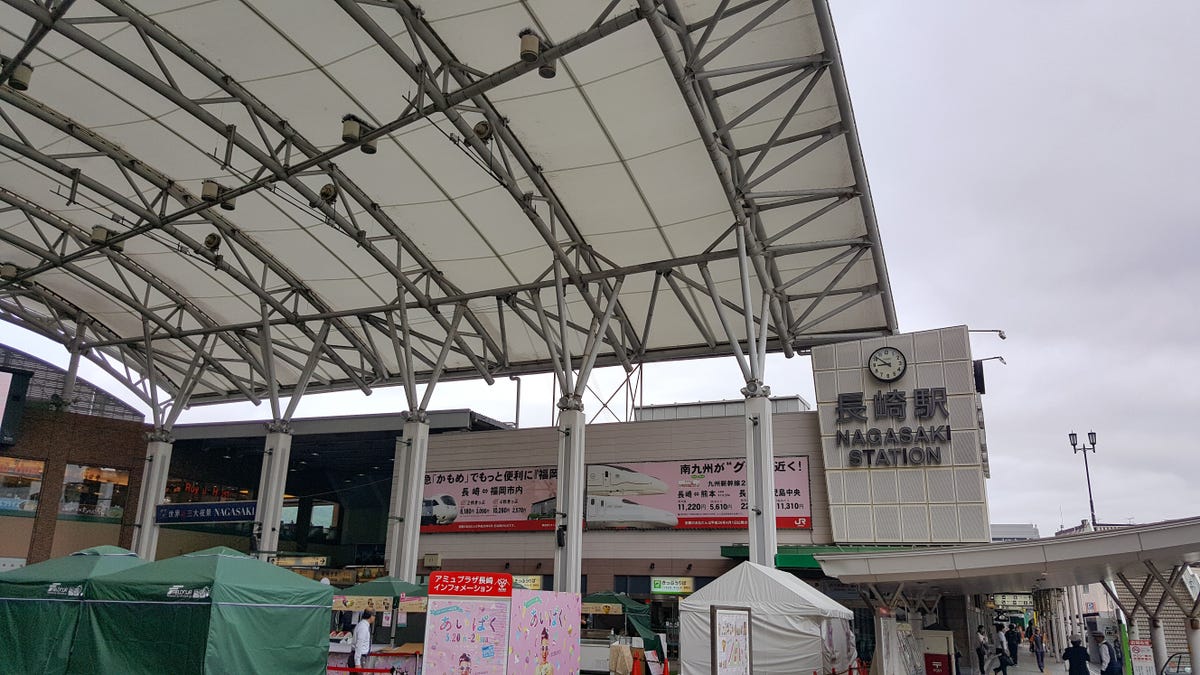8 hours across Japan by train
Riding the rails of Japan: It takes 8 hours to get from Nagasaki to Tokyo. Here's what it's like riding a bullet train and fast regionals across the country.

Though I could have taken a trolley from my hostel to the station, it was easier to just walk. During my visit to Nagasaki the open-air portion of the station was host to an ice cream festival. A city after my own heart.
The ticket machines all over Japan look like this, but thankfully you can select "English" in the menu. It's pretty straightforward: one stop shopping for the tickets to get you across Japan.
Though the high-speed bullet trains, Shinkansens, cover most of Japan, they don't go to Nagasaki. So my first leg was to get from here to Hakata via an 885 series EMU.
These are amazing. I'm not sure the name in Japanese, but they're rice balls in English. Delicious rice with a center of...something. The wrappers were in Japanese. This one was chicken. My favorite was a spicy red one filled with a foodstuff I couldn't identify.
I splurged on Green Cars for the whole route. It's essentially business class, with wood floors, comfy seats and a little table. It was all quite lovely. The regular seats on this train still looked pleasant.
I had hoped the weather would cooperate and let me take many scenic views of the Japanese countryside. But instead I was forced to settle for cloudy scenic views of the Japanese countryside. Though Japan is home to Tokyo, which is the largest city on Earth, and many other massive urban conglomerations, huge swaths of the Japanese islands are rural. This was outside Kubota, about halfway between Nagasaki and Fukuoka.
At each station, including the one where I boarded, the wall here would turn opaque. The rest of the time, like some sort of sci-fi magic, the cloudiness would disappear and I could see outside.
The Green Car on this train was at the back -- or at least, it was at the far end from the direction we were headed. The view from the window was pretty cool.
After a brief stop in Hakata, time enough to grab a boxed lunch, I found my track and waited for this photo. The N700 series is a common sight, though not the only Shinkansen.
My seat for the next 5 or so hours. Big window, adjustable footrest, tray table and a chair that reclined. Not bad. Not bad at all.
The seating arrangement varies on the different lines, but 2x2 is the standard for Green Car seating. The regular cars sit three passengers in a row, but were still far nicer than airline seats.
Normally I'd assume "Train Station Sushi" was a euphemism for "Death Wish" but of course, this is Japan, and you won't get anything less than the finest. This was all surprisingly good.
Another thing you'll find in Japan is countless varieties of iced tea. Walk into any convenience store and you'll encounter entire coolers full of different brands, styles, flavors -- I've never seen anything like it. I tried as many as I could without really knowing what flavor I was getting each time. It was a bit like playing Russian Roulette, but far more delicious.
Though always separated from the surrounding land (usually by height and walls), the amount of separation varies. In the cities, high sound-blocking walls make you feel like the train is speeding through a narrow canyon. In other areas, like here outside Kyoto, it's a bit lower, offering more of a view.
Since they have limited space, the Japanese are experts at building vertically. Rail lines and highways pass by near the roofs of some buildings but only make it halfway up taller ones.
No, I didn't take any pictures of the bathrooms, but the cleanliness and style of this area outside, between two cars, should give you an idea of the facilities' standards.
Heated seats, lights, power outlets...what more does a digital nomad need? Well, free Wi-Fi would have been nice.
Remember what I said about building vertically? Here's a road bridge that goes over a rail bridge, then under a different rail bridge.
A screen grab from the GPS Status app. Pedal to the metal...
Finally, Tokyo station. I was staying a little northwest of here, in a different part of Tokyo near the Skytree, so two more trains awaited: both on the Tokyo subway system.
The stations here are gigantic. From Tokyo station to Akihabara, then up to Asakusa, I finally made it to my hostel. A long day that started many miles south. But honestly, not bad. It was comfortable, quiet, fast, hassle-free and not overly expensive. Quite a pleasant way to cross most of a country.

